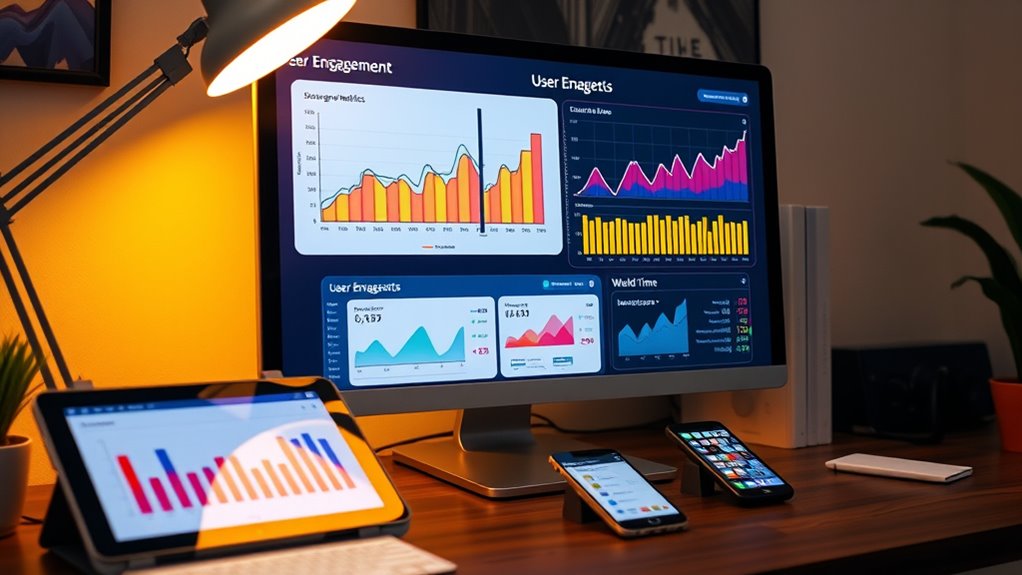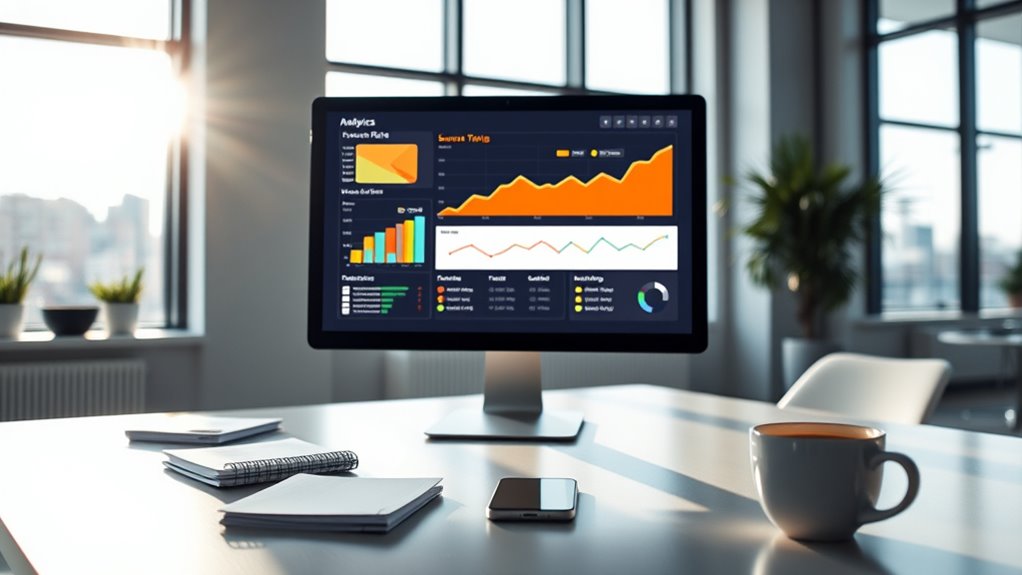To improve your SEO, focus on balancing bounce rate and dwell time by creating engaging, relevant content that meets your visitors’ expectations. Use clear headings, visuals, and interactive elements to encourage longer stays, while ensuring your site loads quickly and is mobile-friendly. Personalize experiences and guide users with compelling CTAs to foster authentic engagement. Continuing to optimize these metrics will help your site rank higher and attract more interested visitors.
Key Takeaways
- High engagement signals like low bounce rate and longer dwell time improve search rankings by indicating valuable content.
- Balancing bounce rate and dwell time requires creating relevant, high-quality content tailored to user intent.
- Enhancing user experience with easy navigation, multimedia, and clear CTAs encourages longer stays and exploration.
- Avoid misleading metrics like clickbait; focus on authentic engagement and content that genuinely satisfies visitors.
- Regularly optimize site speed and accessibility to support positive engagement metrics and SEO performance.
Understanding Bounce Rate and Dwell Time

Have you ever wondered how your website’s visitors are truly engaging with your content? Bounce rate and dwell time are key indicators. A fast page load keeps visitors interested, preventing frustration that leads to quick exits. If your content layout is cluttered or confusing, visitors might leave early, increasing your bounce rate. Dwell time measures how long visitors stay after landing on your page, reflecting the quality of your content and layout. Longer dwell times suggest your content resonates and encourages exploration. Conversely, short dwell times or high bounce rates signal that your page load speed or layout isn’t meeting visitors’ expectations. By optimizing these elements, you improve engagement, which can positively impact your SEO. Understanding these metrics helps you craft a more compelling website experience. Additionally, focusing on color accuracy in images can enhance visual appeal, making visitors more likely to stay longer and explore your site further.
The Role of User Engagement in Search Engine Rankings

Since user engagement metrics like bounce rate and dwell time directly reflect how visitors interact with your content, they also influence your search engine rankings. Search engines interpret high engagement as a sign of valuable content, boosting your visibility. To improve this, you can use personalization tactics to tailor content to individual preferences, making visitors more likely to stay longer. Audience segmentation helps you target specific groups with relevant messaging, increasing overall engagement. Visualize your visitors:
- Traversing through your site with ease, finding what they need effortlessly
- Clicking through multiple pages, exploring related topics
- Spending extended time immersed in your content, reading in-depth
- Incorporating antioxidants from sources like honey can make your content more engaging and informative. Implementing privacy policies and transparent data practices can also foster trust, encouraging visitors to stay longer and interact more with your site.
How Bounce Rate Reflects Visitor Behavior

Bounce rate offers a clear window into how visitors interact with your website. When your bounce rate is high, it often indicates that visitors aren’t finding what they’re looking for or that their intent isn’t being met. This suggests engagement patterns where users quickly leave after viewing only one page, signaling a mismatch between content and visitor expectations. Additionally, understanding narcissistic traits and how they influence behavior can help you tailor content that better captures and retains visitor attention. Recognizing personality traits can further enhance your ability to create targeted content strategies. Conversely, a low bounce rate typically shows visitors are exploring multiple pages, reflecting strong engagement and aligned visitor intent. By analyzing bounce rate, you can identify whether your content resonates with your audience or if adjustments are needed. Keep in mind that a bounce isn’t always negative—sometimes, visitors find exactly what they need on a single page—so understanding the context behind the numbers is essential. Additionally, understanding conversion rates can help you better interpret how bounce rate impacts your overall website performance. For example, if your website features electric bikes, ensuring detailed information about models and pricing can reduce bounce rates and improve engagement, especially when paired with personalized content strategies that meet visitor expectations.
The Significance of Dwell Time for Content Quality

Dwell time measures how long visitors stay on a webpage, serving as a direct indicator of content quality and engagement. When your content aligns with user intent and offers sufficient depth, visitors are more likely to stay longer. Think about a reader exploring:
- An in-depth guide that answers all their questions
- A detailed tutorial that builds their skills
- An insightful article that resonates with their interests
Longer dwell times suggest your content meets their needs and encourages exploration. This signals to search engines that your page provides value, boosting your SEO. Prioritizing content depth and understanding user intent can help you craft pages that keep visitors engaged, lowering bounce rates and increasing dwell time. Additionally, aligning your content with regional bank opening hours can improve the relevance and usability for local visitors. Incorporating content personalization strategies can further enhance user engagement by making content more relevant to individual preferences and needs, while also leveraging insights from prophetic dreams to understand subconscious user motivations. Ensuring your content is well-structured and easy to navigate can also significantly improve how long users stay on your page.
Common Misconceptions About Engagement Metrics

Many people assume that high engagement metrics always mean your content is effective, but that’s a misconception. Some marketers use clickbait tactics to artificially inflate engagement, making it look like their content resonates with audiences. This engagement inflation can mislead your SEO efforts, as metrics like clicks, likes, or time spent might not reflect genuine interest or value. High numbers don’t always equate to quality; they can be the result of sensational headlines or misleading visuals designed solely to boost stats. Relying solely on these metrics can cause you to overlook whether your content truly satisfies user intent or provides meaningful information. Additionally, vetted content is more likely to foster authentic engagement and trust with your audience, especially when it aligns with content quality standards that emphasize accuracy and usefulness. Moreover, understanding the subconscious power during sleep can help you create content that resonates at a deeper vibrational level, leading to more authentic interactions. It’s essential to understand that genuine engagement often stems from trustworthy content, which can lead to better long-term SEO performance and audience loyalty. Incorporating content evaluation methods based on user feedback and behavioral data can further enhance the authenticity of your engagement metrics.
Strategies to Reduce Bounce Rate Effectively

Reducing your bounce rate begins with understanding what drives visitors to leave your site prematurely. To keep them engaged, consider offering personalized content that resonates with their interests, making each visitor feel valued. Incorporate interactive quizzes to actively involve your audience, encouraging them to stay longer and explore further. Visualize your site as a welcoming space where visitors:
Engage visitors with personalized content and fun quizzes to reduce bounce rates and foster lasting connections.
- Find tailored recommendations matching their preferences
- Encounter engaging, fun quizzes that challenge and entertain
- Discover relevant content that keeps them clicking through your pages
- Use sensory engagement techniques such as calming sounds or visuals to create a more immersive experience. Additionally, integrating interior design principles can enhance the overall atmosphere of your website, making it feel more inviting and comfortable for visitors. Applying website ergonomics can also improve the ease with which users navigate your content, further increasing the likelihood of longer visits. Emphasizing mindfulness practices can also foster a more centered and relaxed browsing environment, encouraging longer stays and deeper engagement. Incorporating emotional connection through storytelling and authentic messages can further deepen visitor investment and loyalty.
Techniques to Increase Dwell Time on Your Site

To keep visitors engaged longer, focus on making your content easy to read by improving readability. Incorporate engaging media like images and videos to capture attention, and use clear calls-to-action to guide users through your site. These techniques help create a seamless experience that encourages visitors to stay and explore more. Additionally, highlighting divorce statistics can inform and motivate visitors to delve deeper into your content related to legal resources.
Improve Content Readability
Improving content readability is essential for keeping visitors engaged and encouraging them to stay longer on your site. Well-structured content guides readers seamlessly, making information easy to digest. Use readability techniques like clear headings, short sentences, and bullet points to break up dense text. Focus on creating a logical content structure that flows naturally, helping users find what they need quickly. Visual cues like bolded keywords, ample white space, and concise paragraphs enhance clarity. Imagine a clean layout with distinct sections, where each point stands out clearly, inviting users to continue exploring. These techniques not only improve readability but also boost dwell time, signaling valuable content to search engines. Incorporating Eat More Butter strategies into your content approach can foster innovation and engagement among your team, further enriching the quality of your site. For example, hosting content workshops can help generate fresh ideas and improve overall clarity. Prioritize clarity and simplicity to keep visitors engaged and returning for more.
Incorporate Engaging Media
Incorporating engaging media into your content can substantially boost how long visitors stay on your site. Using interactive media, like quizzes, polls, or sliders, encourages users to actively participate, increasing dwell time. Visual storytelling, through compelling images, videos, and infographics, makes complex information more digestible and keeps visitors engaged longer. These elements break up text-heavy pages and create a richer user experience. When visitors interact with media that resonates with them, they’re more likely to explore your site further. Focus on integrating media that complements your content and adds value without overwhelming your audience. By doing so, you foster a deeper connection, which enhances engagement metrics and positively impacts your SEO efforts.
Use Clear Calls-to-Action
Clear calls-to-action (CTAs) guide visitors toward the next step, keeping them engaged and encouraging longer site visits. Effective call to action strategies provide clear user guidance techniques that reduce confusion and boost interactions. To do this, design CTAs that stand out visually—bright buttons, compelling copy, and strategic placement. Imagine a bright orange button inviting users to “Download Now,” a prominent link labeled “Learn More,” or a clear prompt to subscribe at the end of an article. These elements serve as visual cues, directing visitors seamlessly. Well-crafted CTAs turn passive readers into active participants, increasing dwell time and improving SEO. Focus on clarity, relevance, and placement to maximize their impact and keep users engaged longer on your site.
Balancing Bounce Rate and Dwell Time for Optimal SEO

Balancing bounce rate and dwell time is essential for achieving ideal SEO results because both metrics directly influence how search engines perceive your website’s relevance and quality. To do this effectively, focus on delivering personalized content that resonates with your audience’s interests and needs. When visitors find content tailored to them, they’re more likely to stay longer, increasing dwell time. Additionally, ensure your website is mobile responsive, providing a seamless experience across all devices. A mobile-friendly site reduces bounce rates by making it easier for users to navigate and engage. By combining personalized content with a responsive design, you create an environment that encourages visitors to explore more pages, boosting both dwell time and overall SEO performance.
Tools and Analytics for Monitoring Engagement Metrics

To effectively monitor your engagement metrics, you need the right tools and analytics platforms that provide clear, actionable insights. Heatmaps visually show where visitors click, scroll, and hover, revealing how users interact with your content. Session recordings let you watch real user sessions, helping you identify pain points or confusing navigation. These tools give you a detailed view of user behavior, enabling targeted improvements. Consider integrating platforms like Hotjar or Crazy Egg to access heatmaps and session recordings easily. By leveraging these analytics, you can spot patterns, optimize layout, and enhance engagement strategies. Visual engagement insights are essential for balancing bounce rate and dwell time, ensuring your content resonates effectively with your audience.
Best Practices for Enhancing Overall User Experience

To enhance user experience, start by simplifying your website’s navigation so visitors find what they need easily. Next, guarantee your pages load quickly to keep users engaged and prevent frustration. Finally, make your content easy to read with clear formatting and concise language to encourage longer visits.
Simplify Navigation Structure
Simplifying your website’s navigation structure can considerably improve user experience by making it easier for visitors to find what they need. Focus on a clear menu hierarchy that logically organizes content, reducing confusion. Use straightforward navigation labels that clearly describe each section, helping users understand where they are and where they want to go. Visualize a menu with:
- A clean, tiered hierarchy guiding users seamlessly through your site
- Clear labels that eliminate guesswork and increase click-through rates
- Consistent placement of navigation elements for easy access
Optimize Page Load Speed
A fast-loading website is essential for keeping visitors engaged and reducing bounce rates. Page speed directly influences user experience, so optimizing it should be a top priority. Start by compressing images without losing quality and minify CSS, JavaScript, and HTML files to reduce load times. Implement browser caching to speed up repeat visits and leverage a content delivery network (CDN) for quicker delivery across regions. Don’t forget mobile optimization—ensure your site adapts seamlessly to different devices, as mobile users often have slower connections. Test your page speed regularly using tools like Google PageSpeed Insights, and address any bottlenecks immediately. Improving page load speed creates a smoother user experience, encouraging visitors to stay longer and engage more with your content.
Enhance Content Readability
While optimizing page load speed keeps visitors engaged, ensuring your content is easy to read is equally important for maintaining their attention. Enhancing content readability involves smart visual hierarchy and effective typography choices. Use headings, subheadings, and bullet points to guide readers smoothly through your content. Choose fonts that are clear and legible, like sans-serif styles, and keep font sizes large enough to read comfortably. Pay attention to spacing, contrast, and color to reduce eye strain and improve focus. Visual cues like bold text, italics, or icons can highlight key points. Imagine your content as a well-organized map—clear pathways, distinct landmarks, and easy navigation. These practices make your content more inviting and accessible, encouraging visitors to stay longer and engage deeper.
Frequently Asked Questions
How Do External Factors Influence Bounce Rate and Dwell Time?
External factors like social media can considerably impact your bounce rate and dwell time by driving targeted traffic to your site. High-quality backlinks from reputable sources boost your authority, encouraging visitors to stay longer. Conversely, poor social media engagement or low-quality backlinks may increase bounce rates. You need to focus on creating shareable content and building strong backlinks to improve user engagement metrics effectively.
Can Changing Design Elements Impact User Engagement Metrics?
Changing design elements can profoundly impact your user engagement metrics. By adjusting visual hierarchy, you guide visitors’ attention to key content, encouraging them to stay longer. Incorporating color psychology helps evoke emotions and influence behaviors, making your site more appealing. When you optimize these elements, you make your site more intuitive and engaging, which can lower bounce rates and increase dwell time, ultimately enhancing your overall SEO performance.
What Role Does Mobile Optimization Play in Engagement?
Imagine holding your phone, feeling smooth touch navigation under your fingertips. Mobile optimization plays a crucial role in engagement, ensuring your site is mobile responsive. When your website adapts seamlessly to different screens and offers easy touch navigation, visitors stay longer and interact more. This not only enhances user experience but also keeps engagement metrics healthy. So, optimize for mobile, and watch your audience connect effortlessly, anytime and anywhere.
How Does Content Freshness Affect Dwell Time?
Content freshness directly impacts dwell time because fresh, up-to-date content keeps visitors engaged longer. When you perform regular SEO refreshes, you combat content decay, ensuring your pages stay relevant and valuable. This encourages visitors to explore more and spend more time on your site. By consistently updating your content, you signal to search engines that your site is active, which can improve rankings and sustain user interest over time.
Are There Industry-Specific Benchmarks for Engagement Metrics?
You might wonder if industry-specific benchmarks guide your engagement metrics. While general standards exist, they vary widely across sectors. For example, e-commerce sites often aim for high dwell times, whereas news outlets focus on quick bounce rates. To improve your performance, compare your metrics against industry standards, and adjust your content strategy accordingly. Monitoring these benchmarks helps you identify areas to optimize, ensuring you stay aligned with your industry’s engagement benchmarks.
Conclusion
Think of your website like a bustling cafe. When visitors stay longer, it’s like customers savoring their coffee, enjoying the ambiance. If they leave quickly, it’s like rushing out after a sip. Balancing bounce rate and dwell time guarantees your site’s ‘atmosphere’ invites visitors to linger and engage. Remember, just as a cozy cafe keeps patrons happy, optimizing these metrics keeps your audience connected—and your SEO efforts thriving.









